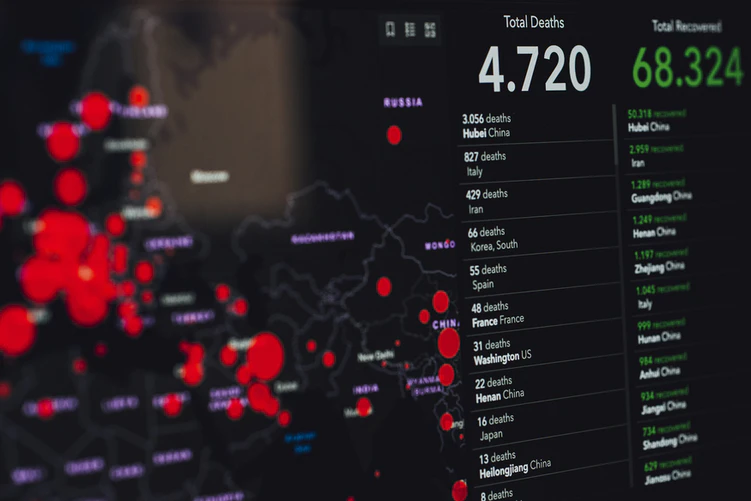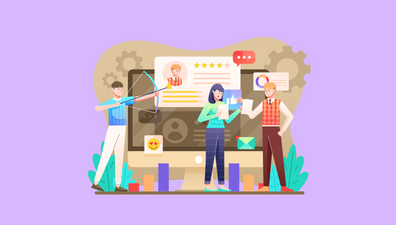Customer Experience (CX) and User Experience (UX) are hugely different, but they both play an important role in providing the best experience for consumers on their complete journey of purchasing and using your brand’s products and services. These two terms also need to be closely coordinated with each other to bring the best experience to consumers of products and services. So how should we understand customer experience vs user experience?
Any brands or businesses that wish to thrive in this highly competitive marketplace must enhance a thorough understanding of both of their customers’ journeys. How their existing and potential customer interacts with the brands? How do the customers feel about the company’s services on their decision-making journey? How do their users experience their applications or websites? Getting a comprehensive understanding of both will enable the business to exert its fullest and overall influence on its target customers.
Designers are the ones that mainly affect the UX. Meanwhile, marketers or customer supporters need to have a better understanding of CX. But is your team able to clearly distinguish between these two confusing concepts? Let’s check and improve your knowledge through the article below.
Table of Contents
Customer experience vs User experience: The definitions
Before advancing to address the question “what are the differences?”, we need to understand the right definitions of these two concepts. “What is CX? What is UX?”. To better understand why customer experience insights can help you design a better user experience, let’s dig deep into these two concepts together.

What is user experience (UX)?
Coming about in the 90s. The concept UX was coined by Don Norman as he was the Vice President that was in charge of the product design department at Apple corporate. In particular, Norman’s consultancy agency – the Nielsen Norman Group defined UX as: “every single aspect of the end user’s interaction with the company and brand, its services or its products”
And rather than just giving you a merely simple definition of each concept, this article will use the bicycle shopping story as a simulated comparison to illustrate to you a closer and more intuitive approach.

UX can be described as your overall experience with the bike as a whole. It is the sum of all part-specific experiences. As a customer who is in your decision-making process, you will ask questions like: What is it like to ride on this bike? Do the parts work together for a totally comfortable experience? Does this bike reach the desired speed? Is it heavy? All of these questions are a combination of user interface (UI) factors and an assessment of the user on the experience of the final product.
In short, UX can be interpreted as the overall perception and feedback of a person resulting from the use or prediction of the use of the companies’ products or services. Usually, UX covers all aspects whenever users interact with a product on their buying and using journey: how it feels to hold the products in their hand, how easy it is to understand the way it works, how are the perceptions about the product when in use, how well it serves the buying purpose of these people, how well it fits into the context in which they are using it, and how effectively the products and service contribute to the quality of life, etc.
What is customer experience (CX)
And what is CX? What are the differences between CX and UX in terms of definitions? CX can be described as the newcomer in this playground. The term customer experience, according to Tony Hillson, the chairman of Service Design NZ, is just 12 years old now and has only become prevalent and widely-used in the communities in the last 6 – 8 years. According to Forrester, CX was defined as: “how customer perceive their interactions with your company or brand”.
As you all can perceive instantly, the main difference has appeared – if the UX concentrates more on the end-user of the business – the person directly using the services or products. Meanwhile, CX pays more focus on the customer – existing or potential.
Often customers and users could be merged as one, as who are using the products or services on their own, but they may be purchasing the products on someone else’s behalf without directly experiencing. That’s why the CX concentrates more on the overall customer’s decision-making journey to optimize the quality of every interaction they have with the brand.

Back to the bicycle shopping story, CX can be described as the experience of the customer in the process of dealing with various aspects of the bicycle company, including the bike itself. Through which channels of advertising do you know about this brand? If your bike breaks down, is it easy to seek the company for help and be resolved satisfactorily and quickly? Is it easy to replace and upgrade spare parts? Are there easy-to-understand instructions to help you repair the bike yourself when a tire is punctured? At this point, not only the product but all the factors the customer requires or expects from the company will be included in the evaluation.
In short, CX is the whole process of interaction between a customer and an organization from the moment a customer learns about the name of the business, searches for information, considers, meets, purchases, after-purchases, and subsequent purchases. Typically, CX is how users perceive the Product Ads, Purchase Process, Product Delivery, and Post-Purchase Customer Service.
Does CX contain UX?
The right answer for this very common question here may be “no and yes”.
In the process of designing a survey or a questionnaire to collect feedback from users and customers, or designing an eye-catching and easy-to-use e-commerce website that may result in sales for the company, UX could be processed as part of the CX plan. Because UX focuses on the products, it can be considered as a specific part of a broader and comprehensive CX operation plan. From this perspective, CX extends beyond UX. Due to the concern of CX with your overall brand as a whole, not just the user’s mere engagement and feelings in using your specific products or services you have designed.
But on the flip side, CX can also be defined as a part of UX while the UX concept is used in a far broader range of settings and organizations in the society, not just merely the business and customer relationship. For example, NGOs, public organizations, governments, schools, or the infrastructures in all areas can utilize UX to enhance the quality of experiences in operation for the users such as visitors, students, patients, etc. It can exert massive influence on a tremendous scale. Facilitating the daily process of paperwork managing and processing of citizens at national organizations, for example.
What is the difference between UX and CX?
Bearing in mind the key difference in definitions that can be used to distinguish these two concepts above. We would dig deeper into details on how the UX and CX are different in many aspects.
Customer experience vs User experience: The goals
Both CX and UX have the same goal of enhancing the experiences of users and customers on both of their journeys of purchasing and using the products and services. This ultimate goal could be achieved by tailoring the strategies or applying consumer-centric design measures. A common-seen part of the job of both the UX and CX specialists are user/customer experience research to identify which areas of the customer journey are causing annoyance to the users, hindering the accomplishments of the business, or causing the users/customers to be frustrated or disappointed when their former expectations and needs aren’t all met.

After successfully identifying the problems of the customers, UX and CX specialist departments would go on to work on proposing feasible solutions to the problems, whether at a CX level (through training and development of staff) or at the UX level (redesign or re-develop the ordering and check out process on the business commerce websites to reduce customers’ churn rates).
Nevertheless, UX and CX optimization concentrate on many certain different sets of purposes:
UX goals:
- Facilitate users to finish the tasks successfully and at ease with a sense of fulfillment.
- Help every users’ interaction with the brands become easy and convenient.
CX goals:
- Offer customers a consistent and high-quality experience every time they interact with the brand at a touchpoint on their journeys.
- Provide customers with an experience that stands out from competitors of the brand and give a strong point of brand positioning.
- Nourish customer loyalty and brand advocacy.
- Build strong brand equity, brand love, and brand trust.
Customer experience vs User experience: The activities

While the CX and UX specialists’ main practices overlap remarkably in many aspects, there are certain and obvious differences.
UX activities list:
- Developing and Designing a single platform served only for one kind of interactions, such as digital tools, phone services, or commerce websites.
- Initiating different researches on the product and develop user’s personas.
- Testing and developing the platform designs using end-users feedback.
- Coordinating closely with product owners, product managers, and product developers to keep track and take care of the end-user at every stage of their journeys.
Otherwise, CX practices are often wider and cover more aspects. As well as the UX practices above, CX specialists will:
- Conduct the customer experience research and draw maps of customer journeys using a range of data and insights collected.
- Do the market research and listen to the customer to develop a better understanding of customers’ behaviors, emotions, feelings, and drivers.
- Closely work with all management levels of the business to understand the business goals.
- Develop high levels of customer service, customer support, communication, and transparency in order to deliver a good customer experience.
Customer experience vs User experience: Key metrics

Another feature to compare customer experience vs user experience is the metrics used to measure these two concepts. The vital metrics that CX specialists often utilize to measure and evaluate their success often bear little resemblances to those that UX professionals use in their daily works. Customer experience specialists often evaluate the feedback from customers on how they feel about the overall experience that the brands offer through their constant interactions with the touchpoints on their journeys. CXers also work to analyze the number of customers the business has gained or lost over a period of time.
Due to that reason, the churn rate, retention rate, customer lifetime value, customer effort score, or net promoter score are all very familiar with CX professionals. The research conducted by the CX department is often with the purpose of evaluating customer loyalty and brand advocacy. UX specialists, on the other hand, make use of metrics that show the level of satisfaction of the users when interacting with the product and the usability of it. App store ratings, constructive reviews, surveys, and questionnaire forms are often used by UX professionals to record the rate of fulfillment a user feels when using the product or service.
>> Read more: Customer Experience vs Customer Service vs Customer Care
Customer experience vs User experience: The effects
To grasp a better understanding of the profound impact of UX and CX on consumer buying decisions, let’s analyze the following case studies.
Poor UX, great CX
Let’s imagine: you bought a photo editing app on the App Store. You purchased the app because you want to be provided with unique editing features like Photoshop on your phone. However, when you start experiencing the application, you find its interface somewhat very confusing and annoying, even difficult to find the features you want.
Fortunately, you are able to respond to the developer through your communication channels. You call and a customer service officer responds and explains quickly, giving you step-by-step access to the features you want. Everything seems clearer. Plus, you get $25 free to use to compensate for the problems you have.
This is an example of poor UX, but the CX is very good. The app’s interface doesn’t meet the needs of the user, but their customer experiences with the company and the brand are much better and salvageable.
And here is another case:
Poor CX, great UX
Imagine you want to book an early flight. You intended to download the airline’s application to buy tickets right on your smartphone. It’s great that even if you haven’t used it before, its easy-to-use interface, clear instructions and navigations, plus quick loading time have taken you less than 10 minutes to book your desired flight.
But when you got to the airport, the story changed 180 degrees. The check-in counter was understaffed and passengers were lined up. The flight attendant is unfriendly and makes you quite uncomfortable with the way they throw your luggage around. During the flight, your experience was not pleasant either.
In this case, you can easily see that while the customer experience that the brand offers is way too bad, no matter how good the app’s UX design was, it can’t make up for the frustrating services, which damages the overall customer experience.
In short, to fully satisfy your customers, you need to consistently focus on both the UX and CX.
Conclusion
It’s not easy to distinguish customer experience vs user experience. As such, UX is one of the strongest influences across the entire CX – but both CX and UX play a key role in the ultimate success of a business. Failure in either area leads to a bad customer experience in general, and so companies must continually optimize both if they want to remain competitive and delight users/customers. on every touchpoint.











